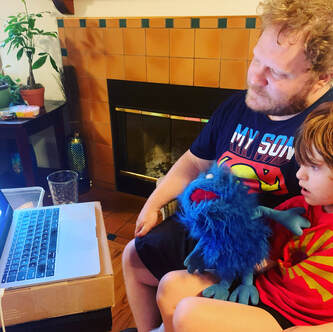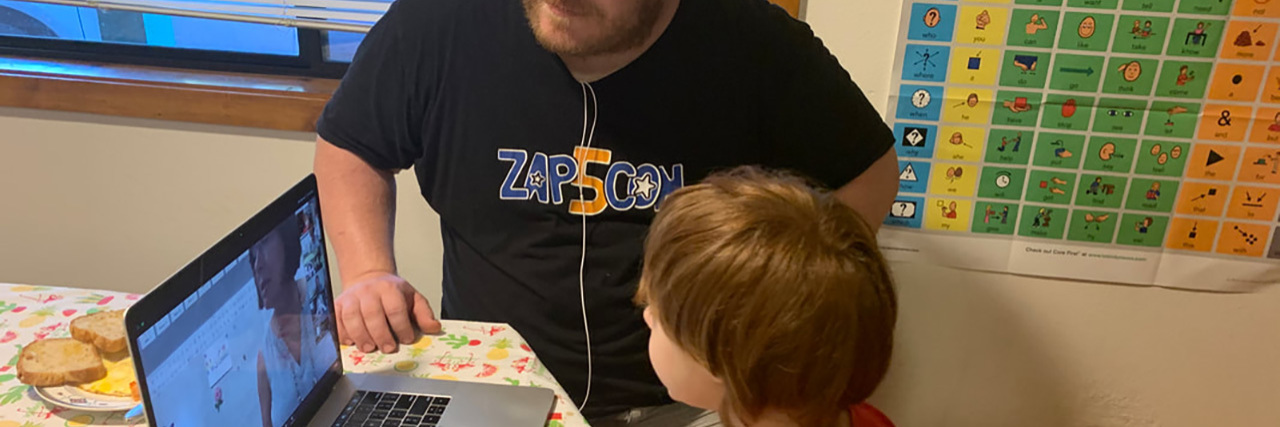For many parents, having a school-aged child sucks right now, and having a school-aged child with disabilities is unbelievably difficult.
There’s this thing that seems to be missing in our national dialogue about schooling during the pandemic, and that is the fact that most of us need our children to go to school so we have childcare for them. I don’t understand how parents are doing this. Teaching our young children at home requires near-constant vigilance. It is a logistically impossible situation for most families, made all the more difficult by the fact that we aren’t automatically giving parents funding to stay home and teach their children until school can be in person again.
My family is lucky enough that we can work from home and have enough flexibility to care for our children, but it still feels impossibly hard. Our son Benny has a dual diagnosis of autism and Down syndrome and has been home with us full time without any kind of childcare or in-person support for his extra challenges since mid-March. And we are exhausted. Not just the exhausted like I need a day to myself to recover and I’ll be fine, the exhausted like I am so physically, emotionally, mentally and spiritually tired that I don’t know how I can go on another moment kind of exhausted.
And in the midst of this exhaustion, my son started kindergarten. And instead of a bus coming and whisking him away so my husband Max and I could have a little break, we are being forced into some kind of horrible punishment for parents called “distance learning.” And for us, distance learning entails pretending that my son is going to learn something from a series of Zoom calls with his teacher when we can’t even get him to put pants on anymore.
The jig is up. We don’t know what we’re doing, the school doesn’t know what it’s doing, and my son is no fool. He’s not going to sit down in front of the computer and smile and nod while his teacher tries to pretend this is anything like a kindergarten classroom. Add to that the fact that the therapies he receives from the school are also only being given over Zoom, and we can basically guarantee that this is a lost year for Benny — and our family.
Every project that he needs to do has to be prepared by us and we have to assist him for every aspect of it. The occupational therapist sends us a project for us to have ready and asks if we can prepare it for the session. Can we print out this pdf? Can we cut it out ahead of time? Can we have tongs and little bowls and play dough available? There is a long list of school supplies to have on hand, scissors, glue, paint, crayons, q-tips…
Later I look through the directions, and sit down to cut out the forms. It’s all so much work, but if I don’t find some way to do this I will fail my child. Every aspect of Benny’s education is now up to us.
We knew from trying to do distance learning and distance therapies at the end of the last school year that Zoom wasn’t going to work for him as a replacement for kindergarten, but we decided to give it a try anyway because we don’t know what else to do.
On the first day of classes, we were surprised to find out he only had one half-hour session at the end of the day in the general education classroom on his schedule, and everything else was in special ed. Even though I knew the Zoom format wasn’t going to work for Benny either way, I was taken aback that this was the setup after we had worked so hard to make sure he was going to be in the general education classroom as much as possible, and this was supposed to be at least 60% of the time according to his Individualized Education Plan (IEP). We are now looking at less than 25% of his time being spent in the gen ed class.
We met with the special education teacher and the special education director and told them how upset we were about this. They agreed to add Benny to the other general education zoom calls for now to see how it would go. We decided to give it a try, because at the very least we could see what he was going to be missing out on.
The first general education kindergarten Zoom class we tried to participate, in the teacher admonished the kids to sit up straight, pay attention, and speak clearly and appropriately in their responses. This last part was heartbreaking for us, because Benny has a major speech delay. He uses a combination of verbal approximations, sign language and a communication device we call his “talker” for the majority of his communication.
That morning the teacher proceeded to call on every child to say “good morning” to the class. If we had been prepared for this, we could have made sure to practice using his talker, but instead, he was left out. I started to ask myself, why had I pushed for him to be in this class? Wouldn’t it just be easier to accept that he belongs in special ed?
Max has taken time off this week to help get kindergarten sorted out. He spent most of the Zoom classes doing everything in his power to get Benny to sit for more than two minutes straight. “This isn’t working out,” we agree. “He doesn’t like either, but he spends more time paying attention to the special education Zoom calls,” Max says. “Maybe we should just–” I stop him and ask him to wait, let me write about this so I can gather my thoughts together, figure out how to explain to him why I don’t want to give up on fighting for inclusion. Even if it is a pandemic. Even if we are both so tired we have almost no fight left.

In an ideal world, Benny would be in a class with support for his speech delays and a mixture of kids of all abilities to interact with and model behavior from. But it is far from an ideal world. In the world we’re in we have to decide between a class with typical peers, high expectations and no support, or a class of peers with disabilities, low expectations and some support. And neither class is in a format that works for him. There are no good options here.
And the thing is, I don’t know what the right thing is for Benny in this situation. How do we fight for inclusion when we’re confined to our homes? If we are all socially distancing, what is there to be included in?
The other day, I was briefly on social media because I’ve mostly been avoiding it to protect my mental health. I saw a post that I tried to unsee: another mom of a child with Down syndrome sharing screenshots of an ugly conversation. A parent in a district that was only letting kids with disabilities attend school wrote that letting children with disabilities attend school was unfair because they aren’t going to do anything with their lives anyway, so why should they get extra resources that the rest of the kids don’t?
It hurts.
How our society treats its most vulnerable members shows how well, or how poorly, that society is doing. We are not doing OK. Everyone is scared, resources are scant, and the first to get turned against are the ones who most need to be protected.
Ultimately, I know there is an answer somewhere, and it’s not in pretending that a Zoom call with a teacher can replace a classroom. These Zoom calls don’t work for my son, and they don’t work for my family.
In my heart, I am still an optimist. I believe in human ingenuity. Maybe it’s time to rethink the whole thing. Maybe all of our systems are failing, and it’s OK to let them fail because they were never that good to begin with.
If I look at it from a different angle, I can be grateful for distance learning because now I can see what was so clearly missing at this school all along. Inclusion has never meant sticking a child with disabilities in a general education classroom just so they can meet some ratio on paper. Putting a child with disabilities in any kind of classroom without giving them the proper supports is setting them up to fail.
And just like Benny was set up to fail in the general education classroom, we were set up to fail here at home. It hurts because what we are failing at is so critical. Most kids will catch up, but when our son is already so far behind, how will he ever be able to catch up?
When I reimagine an education system in which my son is truly included, even during social distancing, I imagine a system that optimizes the experience for every student. One in which we use technology as an equalizer, and take the time to make sure that each child has their own individualized education plan, not just the ones who are identified as having disabilities.
Why can’t we have that? If we’re stuck at home using technology to learn anyway, why not take advantage of this time to make everything more accessible for everyone?
I think about my own schooling, and how ridiculous it all was. The way I was made to feel bad about myself because of the challenges I had with organization, and the struggles I had with boredom. So much of the work seemed pointless, and looking back as an adult I can confirm, it was.
Numbers were gathered and used against us as weapons. We were categorized and sorted into groups according to standards that upon further reflection are completely irrelevant in any sort of real way. All these years later, I am sending my kids to school and seeing that we have continued to shape our education system based on these standards even though all of the research about how people learn shows this doesn’t work.
We don’t have to do this anymore. There is no future in it. It’s a flawed system that barely worked before and it’s completely broken now.
Life is short, and the world is on fire. There’s no time to pretend that this messed-up system of ours is still working. It’s broken, I’m broken, I’m at my end of being able to pretend like everything is OK. I can’t do this and I shouldn’t have to. There’s got to be a better way. Not just for Benny, for us all.

